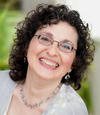When someone advises you to "take a deep breath" what do you actually do? How does it feel in your body? Try it right now, paying close attention to the front of your body. Where does the movement of the breath come in?
I'm guessing you probably felt it most in your chest. You also probably drew that breath in with great force, as if "deep breath" was a foreign entity that lived somewhere outside your body. Maybe you took two or three aware breaths and then went back on automatic pilot.
The weird thing about breathing is it happens without our ever having to think about it, yet most "staying alive" breathing only uses about 1/3 to 1/5 of our lungs' natural capacity! As one of the few things in life that is completely tied to all of our body functions, emotional states and even spiritual alignment, it is absolutely essential that we do it well.
Learning how to work with my breath has saved my psyche and nurtured my heart. This was especially true during the years I spent living part-time with my mother as her health declined and her body lost functionality. She had terrible arthritis in her hands, so I'd open jars and packages for her and look for mugs that were light and had large handles. She developed spinal stenosis, so I would take out the garbage, trek down to the basement with the laundry, and do her food shopping when she had to stop driving.
Mom was also a smoker, much to my chagrin. Losing her ability to knit, bake and be independent left her with little else that gave her a sense of autonomy and pleasure, but she could still hold a cigarette. And there I was, Ms. Holistic Practitioner, eating mainly whole foods, meditating, practicing yoga and taking care of others who wanted to live healthier lives. It was probably our biggest bone of contention and not without irony -- me teaching clients to breathe more effectively while she willfully deprived her cells of oxygen.
Those last few years before she died were full of sweetness and heartbreak, anger and frustration. And when it all was too much, or I just needed a time out, I would go to my room and simply breathe.
So what were the three secrets I worked with for maximum support?
1) A Soft Belly Is A Beautiful Belly
Contrary to popular beauty advice (or fears) that make you want to suck in your stomach, a soft belly is a supple belly. It enhances full body breathing and will not (another fear) lead to a bad back. When your belly is soft and expands on the inhale, your diaphragm -- the main muscle of respiration -- engages more completely, lowering to allow more space in your ribcage. It allows all of the muscles of respiration to work beautifully together to increase oxygen flow to all of your tissues and organs.
2) Breathing Is A Multi-Dimensional Activity
If you have worked with your breath, you still may have only been focused on the front of your body -- the rise and fall of your belly and chest, which is wonderful. But breathing also happens in your sides and back. Envision the entire ribcage as a bellows that opens 360 degrees with each inhale. Bring your awareness to the sides of your body; tune in to the movement of your back as you inhale and exhale. You might even want to place your hands there for increased focus. How many places in your torso can you feel your breath?
3) Breathing Is Automatic, But We Still Need To Practice
The biggest secret of all is that, simple and redundant as it seems, practicing full body breathing is the absolutely best thing you can do for your well-being. Period. It reduces anxiety , calms the nervous system, increases the flow of nutrients to all of your tissues and helps your body release toxins more effectively. Remember, " inspiration " has many meanings, and all of them are enlivened by enjoying complete, full breaths.
Sharon Rosen was born to explore, integrate and share an array of the world's most effective healing tools and techniques. Since 1987 she has been a massage therapist, energy healer, wellness coach, teacher and writer, guiding clients from overwhelm, frustration and pain to clarity, ease and relief. She lives in New York's beautiful Hudson Valley with her husband, breathing, hiking, and enjoying good food and music with friends.
Her first book, Crazy World, Peaceful Heart: 6 Core Practices for Cultivating Joy and Resilience was published in October 2012 and is available through her website, www.amazon.com , www.barnesandnoble.com and for Kindle and Nook. You can download your free Peaceful Heart Toolkit and receive regular self-care tips in the Midweek Mindful Moment at www.heartofselfcare.com


